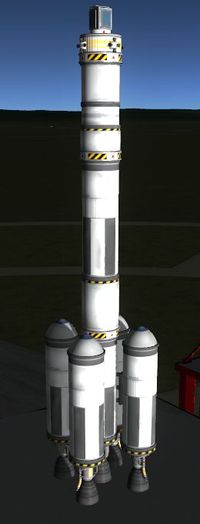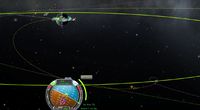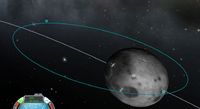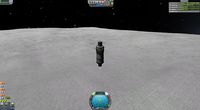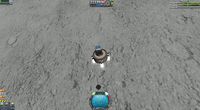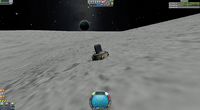Difference between revisions of "Tutorial: Luna 9"
Austinyates (talk | contribs) m (→Braking maneuver: corrected several instances of misspelled "braking" and other typos.) |
SlayerGames (talk | contribs) m (Fixed categories) |
||
| (14 intermediate revisions by 9 users not shown) | |||
| Line 1: | Line 1: | ||
| + | {{Outdated| | ||
| + | * This article is based on a version of KSP which is over a year old and doesn't account for several gameplay changes and content additions.}} | ||
| + | |||
{{Quote|We choose to go to the moon in this decade and do the other things, not because they are easy, but because they are hard.|John F. Kennedy}} | {{Quote|We choose to go to the moon in this decade and do the other things, not because they are easy, but because they are hard.|John F. Kennedy}} | ||
| Line 5: | Line 8: | ||
The Soviets also managed to do three sample-return missions from the moon (Luna 16, 20 and 24). Launching an unmanned spacecraft to another celestial body and returning with a soil sample is a feat not reproduced by anyone else to this day. This feat, however, was diminished by happening after Apollo 11 returned with soil samples from the moon, so their scientific value wasn't as high as anticipated. | The Soviets also managed to do three sample-return missions from the moon (Luna 16, 20 and 24). Launching an unmanned spacecraft to another celestial body and returning with a soil sample is a feat not reproduced by anyone else to this day. This feat, however, was diminished by happening after Apollo 11 returned with soil samples from the moon, so their scientific value wasn't as high as anticipated. | ||
| − | In this mission we will re-enact the flight of Luna 9, the first soft landing on the moon. | + | In this mission we will re-enact the flight of Luna 9, the first soft landing on the moon. |
| + | |||
== Ship Setup == | == Ship Setup == | ||
[[File:Luna-launch.jpg|right|200px|start configuration]] | [[File:Luna-launch.jpg|right|200px|start configuration]] | ||
| − | The original Luna 9 landed by deploying a large airbag to cushion its impact. Unfortunately KSP hasn't got anything like that as of version 0. | + | The original Luna 9 landed by deploying a large airbag to cushion its impact. Unfortunately KSP hasn't got anything like that as of {{version|1.0.5}}, so we will do a landing with rockets instead. |
| − | The probe itself will be as minimalistic as possible. We use the [[Probodobodyne QBE]] as control unit. It's the most impact-resistant command pod available and thus has the best chances to survive the impact on the | + | The probe itself will be as minimalistic as possible. We will use the [[Probodobodyne QBE]] as the control unit. It's the most impact-resistant command pod available and thus has the best chances to survive the impact on the Mun surface, should we screw up the landing. We will plaster its surface with [[OX-STAT Photovoltaic Panels]] for energy supply. The lack of a battery means that the vessel will be non-functional when in the shade of Kerbin or the moon. We will have to keep this in mind. |
| − | Like most Soviet space mission, the rocket was based on the R-7 design. The rocket used for the Luna mission was basically the same which brought Sputnik and Gagarin into space, just with yet another additional stage. I did, however, took the liberty of increasing the size of the tanks of the first and third stage and upgrade the engine of the third stage < | + | Like most Soviet space mission, the rocket was based on the R-7 design. The rocket used for the Luna mission was basically the same which brought Sputnik and Gagarin into space, just with yet another additional stage. I did, however, took the liberty of increasing the size of the tanks of the first and third stage and upgrade the engine of the third stage <s>because it wouldn't work otherwise</s> to account for numerous small advances in propulsion technology. |
* Payload stage | * Payload stage | ||
** 1x [[Probodobodyne QBE]] | ** 1x [[Probodobodyne QBE]] | ||
| − | ** 5x [[OX-STAT | + | ** 5x [[OX-STAT Photovoltaic Panels]] |
** 1x [[FL-R25 RCS Fuel Tank]] | ** 1x [[FL-R25 RCS Fuel Tank]] | ||
** 4x [[RV-105 RCS Thruster Block]] | ** 4x [[RV-105 RCS Thruster Block]] | ||
| Line 45: | Line 49: | ||
=== Lift-Off === | === Lift-Off === | ||
| − | Use the first two stages to get into orbit and the third to circularize it and get rid of any declination to the orbit of | + | Use the first two stages to get into orbit and the third to circularize it and get rid of any declination to the orbit of Mun. |
| − | === Going to the | + | === Going to the Mun === |
[[File:Luna-trajectory.jpg|right|200px|Trajectory]] | [[File:Luna-trajectory.jpg|right|200px|Trajectory]] | ||
| − | Get into a transfer orbit just like in the "Going to the | + | Get into a transfer orbit just like in the "Going to the Mun" ingame tutorial: Wait until the Mun is 100° ahead of your periapsis and then plan a prograde acceleration maneuver on it which leads you straight to the Mun. Try to find a trajectory which gets you close, but not on a collision course. You can check the closest distance of your course by checking the height of the Mun periapsis. When there is no periapsis marker, you are on a collision course. |
Remember that our probe won't work in the darkness, so make sure that the maneuver is on the daylight side of Kerbin. | Remember that our probe won't work in the darkness, so make sure that the maneuver is on the daylight side of Kerbin. | ||
| Line 56: | Line 60: | ||
After you performed the acceleration maneuver, check your trajectory again to make sure that it really points to the moon and correct if necessary. The earlier you correct your course the less fuel will it cost you. Also don't miss any vertical difference. The best way to correct this is at the ascending/descending node. | After you performed the acceleration maneuver, check your trajectory again to make sure that it really points to the moon and correct if necessary. The earlier you correct your course the less fuel will it cost you. Also don't miss any vertical difference. The best way to correct this is at the ascending/descending node. | ||
| − | === Getting into | + | === Getting into Munar orbit === |
[[File:Luna-orbit.jpg|right|200px|Orbit]] | [[File:Luna-orbit.jpg|right|200px|Orbit]] | ||
| − | As soon as you entered the sphere of influence of | + | As soon as you entered the sphere of influence of Mun (you notice because your trajectory suddenly changes) plan a maneuver to get onto a circular orbit. The most efficient way to do this is by boosting retrograde on the Mun periapsis. Again, start your burn a bit early. Our engine isn't the strongest one, so we might need a very long burn duration. When you don't have much fuel left, you might decide to skip orbiting and go for a straight-on collision course the moment you enter the sphere of influence. |
| − | + | Mun has no atmosphere and hasn't got many high mountains, so an orbit of just a few thousand meters is safe and will give you a great view. Maybe you will even spot one of the legendary Mun arches. | |
=== Braking maneuver === | === Braking maneuver === | ||
[[File:Luna-down.jpg|right|200px|decelerating]] | [[File:Luna-down.jpg|right|200px|decelerating]] | ||
| − | After you enjoyed the view from orbit it's time to land. Boost retrograde to get onto a course which gets you to the surface. Note that because | + | After you enjoyed the view from orbit it's time to land. Boost retrograde to get onto a course which gets you to the surface. Note that because the Mun has no atmosphere, you can control exactly the location where you want to land, but be sure to correct for the rotation of the Mun. Remember the energy problem of our probe: Land on the day side. Also try to land in a very steep angle - it makes the braking maneuver easier. |
The most important thing when doing a landing on a planet without an atmosphere is to not lose your nerves and start wasting fuel by braking too early. The faster you go, the less time you spend in the gravity field, and the less speed will be added which you have to kill. The later you brake, the more fuel-efficient will it be. To keep track of how much time you have left, set a maneuver point on the surface. | The most important thing when doing a landing on a planet without an atmosphere is to not lose your nerves and start wasting fuel by braking too early. The faster you go, the less time you spend in the gravity field, and the less speed will be added which you have to kill. The later you brake, the more fuel-efficient will it be. To keep track of how much time you have left, set a maneuver point on the surface. | ||
| − | When you start to panic, go into staging view, face the retrograde marker and boost forward. Watch your speed and try to get it gradually lower. A good rule of thumb is to regulate it so you have 1 m/s for every 100 meter of altitude. | + | When you start to panic, go into staging view, face the retrograde marker and boost forward. Watch your speed and try to get it gradually lower. A good rule of thumb is to regulate it so you have 1 m/s for every 100 meter of altitude. |
[[File:Luna-landing.jpg|right|200px|landing]] | [[File:Luna-landing.jpg|right|200px|landing]] | ||
| Line 80: | Line 84: | ||
== What next? == | == What next? == | ||
| − | Now that you have tasted | + | Now that you have tasted Mun soil, the next step is obvious: [[Tutorial: Apollo 11|Bring a Kerbal to the Mun and back]]. |
| − | [[Category:Tutorials]] | + | [[Category:Tutorials|Luna 9]] |
| − | [[Category:Historical Spaceflights]] | + | [[Category:Historical Spaceflights|Luna 9]] |
Latest revision as of 20:01, 2 May 2019
This page or section is in need of being brought up to date. Please help Kerbal Space Program Wiki by fixing inaccurate or outdated information.
|
| “ | We choose to go to the moon in this decade and do the other things, not because they are easy, but because they are hard. — John F. Kennedy |
” |
An often overlooked achievement of the Soviet space program were the unmanned Lunik and Luna probes. Sure, most of them failed in various ways, but those which actually completed their objectives were groundbreaking. The Americans might have been the first and only to actually walk on the moon in person, but the first object to reach the moon was Luna 2, the first pictures of the far side of the moon were taken by Luna 3 and the first soft landing on the moon was Luna 9.
The Soviets also managed to do three sample-return missions from the moon (Luna 16, 20 and 24). Launching an unmanned spacecraft to another celestial body and returning with a soil sample is a feat not reproduced by anyone else to this day. This feat, however, was diminished by happening after Apollo 11 returned with soil samples from the moon, so their scientific value wasn't as high as anticipated.
In this mission we will re-enact the flight of Luna 9, the first soft landing on the moon.
Contents
Ship Setup
The original Luna 9 landed by deploying a large airbag to cushion its impact. Unfortunately KSP hasn't got anything like that as of version 1.0.5, so we will do a landing with rockets instead.
The probe itself will be as minimalistic as possible. We will use the Probodobodyne QBE as the control unit. It's the most impact-resistant command pod available and thus has the best chances to survive the impact on the Mun surface, should we screw up the landing. We will plaster its surface with OX-STAT Photovoltaic Panels for energy supply. The lack of a battery means that the vessel will be non-functional when in the shade of Kerbin or the moon. We will have to keep this in mind.
Like most Soviet space mission, the rocket was based on the R-7 design. The rocket used for the Luna mission was basically the same which brought Sputnik and Gagarin into space, just with yet another additional stage. I did, however, took the liberty of increasing the size of the tanks of the first and third stage and upgrade the engine of the third stage because it wouldn't work otherwise to account for numerous small advances in propulsion technology.
- Payload stage
- Fourth stage
- Third stage
- Second stage
- First stage
Mission Phases
Lift-Off
Use the first two stages to get into orbit and the third to circularize it and get rid of any declination to the orbit of Mun.
Going to the Mun
Get into a transfer orbit just like in the "Going to the Mun" ingame tutorial: Wait until the Mun is 100° ahead of your periapsis and then plan a prograde acceleration maneuver on it which leads you straight to the Mun. Try to find a trajectory which gets you close, but not on a collision course. You can check the closest distance of your course by checking the height of the Mun periapsis. When there is no periapsis marker, you are on a collision course.
Remember that our probe won't work in the darkness, so make sure that the maneuver is on the daylight side of Kerbin.
After you performed the acceleration maneuver, check your trajectory again to make sure that it really points to the moon and correct if necessary. The earlier you correct your course the less fuel will it cost you. Also don't miss any vertical difference. The best way to correct this is at the ascending/descending node.
Getting into Munar orbit
As soon as you entered the sphere of influence of Mun (you notice because your trajectory suddenly changes) plan a maneuver to get onto a circular orbit. The most efficient way to do this is by boosting retrograde on the Mun periapsis. Again, start your burn a bit early. Our engine isn't the strongest one, so we might need a very long burn duration. When you don't have much fuel left, you might decide to skip orbiting and go for a straight-on collision course the moment you enter the sphere of influence.
Mun has no atmosphere and hasn't got many high mountains, so an orbit of just a few thousand meters is safe and will give you a great view. Maybe you will even spot one of the legendary Mun arches.
Braking maneuver
After you enjoyed the view from orbit it's time to land. Boost retrograde to get onto a course which gets you to the surface. Note that because the Mun has no atmosphere, you can control exactly the location where you want to land, but be sure to correct for the rotation of the Mun. Remember the energy problem of our probe: Land on the day side. Also try to land in a very steep angle - it makes the braking maneuver easier.
The most important thing when doing a landing on a planet without an atmosphere is to not lose your nerves and start wasting fuel by braking too early. The faster you go, the less time you spend in the gravity field, and the less speed will be added which you have to kill. The later you brake, the more fuel-efficient will it be. To keep track of how much time you have left, set a maneuver point on the surface.
When you start to panic, go into staging view, face the retrograde marker and boost forward. Watch your speed and try to get it gradually lower. A good rule of thumb is to regulate it so you have 1 m/s for every 100 meter of altitude.
When you almost touch the ground, kill your engine (if it's on while you separate, it will stay on after separation, fly around uncontrolled and possibly hit and damage your probe), release the satellite and maneuver it to the ground using monopropellant.
What next?
Now that you have tasted Mun soil, the next step is obvious: Bring a Kerbal to the Mun and back.
